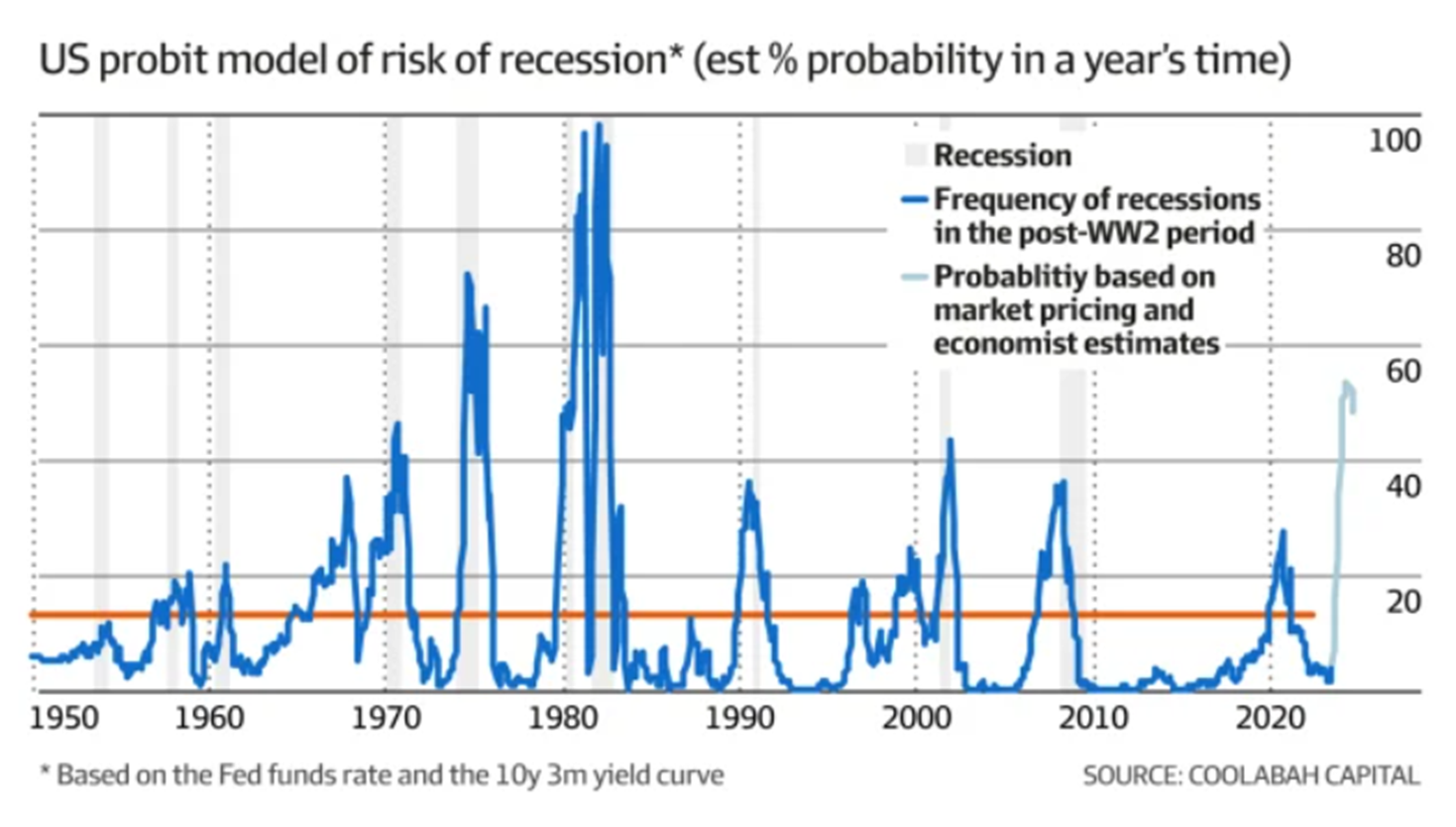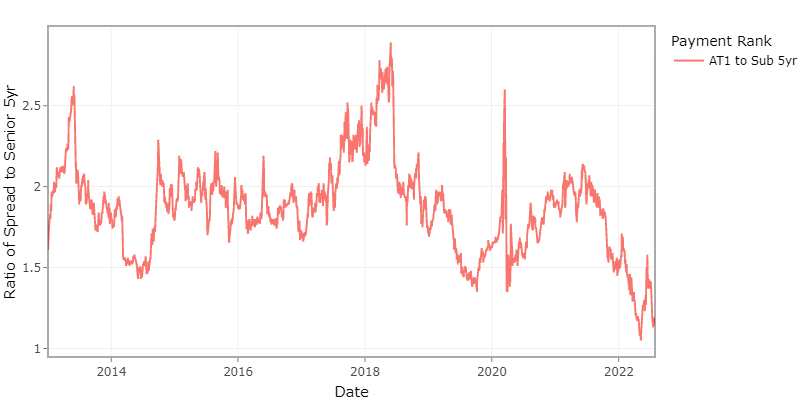US recession signals a possible turning point for asset prices
We have consistently forecast a US recession using models that draw on both bond and equity market data. Our preferred bond market model was reporting the highest probabilities of a US recession since the early 1980s. In fact, when our chief macro strategist Kieran Davies ran this model all the way back to 1950, it had a perfect strike-rate anticipating US recessions when the probabilities were as high as those we published in April.
On Thursday last week, the US officially entered a technical recession after experiencing the second consecutive quarter of negative economic growth, which is the most commonly used definition. Our model pointed to a recession emerging in 2023, so this technical dip is earlier than expected. But there is doubtless much more demand destruction—and economic adversity—to come as the sharp increase in US interest rates crushes activity.

This is why the bond market is signalling that the Federal Reserve will have to eventually cut rates. The current US 10-year government bond yield of 2.7 per cent is materially below the peak cash rate of 3.3 per cent that the market believes the Fed will hit by the end of this year. Put another way, the yield curve is inverted.
The zeitgeist is now changing for all asset-classes, which is important to wrap your head around. In late 2021, we were publicly very negative on everything, including fixed-rate bonds, credit spreads, equities, property and crypto. Our central case was that US equities would fall by more than 30 per cent as the US 10-year government bond yield climbed from its 1 per cent level at the time to north of 3.2 per cent (it eventually hit 3.4 per cent). The trigger for these moves would be the need for the Fed to lift its cash rate to 2.5-3.0 per cent, miles above the 1.3 per cent market forecast at the time. This would smash fixed-rate bonds and push global credit 75-125 basis points wider. As it happened, fixed-rate bonds reported record losses of 12-15 per cent while credit spreads leapt 100-150 basis points wider.
One event that surprised us was the parallel explosion in 10-yar Australian swap spreads, which moved much higher than comparable global swap spreads, as a result of the unprecedented events surrounding the Reserve Bank of Australia dumping its 2024 yield curve target in October last year. (The RBA technically failed to defend the target and then dropped it at its November board meeting.)
This imposed massive losses on global investors that were long Aussie bonds on the basis they believed in the RBA's public commitment to keeping the yield on the 2024 Commonwealth bond at 0.1 per cent. The shock of the dramatic shift in policy, and the subsequent vaporisation of liquidity in the swaps market, meant that it has taken some larger investors many months to exit their positions, which have only recently cleared.
Higher swap spreads created a chain-reaction across other markets as investors use swaps to manage their interest rate risk. As hedging costs jumped, the market demanded even larger yields from other, ostensibly unrelated, assets as compensation.
Since the second half of 2021, we have monetised around $8.2 billion of credit shorts to capitalise on wider spreads, primarily focussed on US and European credit, as an expression of our negative outlook.
But we now face a very different world. The assets we sold last year suddenly look attractive again. As one example, the major banks’ 5-year Tier 2 bonds paid a miserly 1.25 per cent spread above the quarterly bank bill swap rate (BBSW) last year. And BBSW was just 0.01 per cent. So your total yield was only 1.26 per cent.
Last week NAB issued a new 5-year Tier 2 bond that offered a near-record 2.80 per cent spread above BBSW. And BBSW has surged to 2.2 per cent. You were now getting a floating-rate yield of 5.0 per cent compared to the 1.26 per cent available last year.


NAB offered a fixed-rate version of this bond that paid an even chunkier yield of 6.44 per cent annually. (The fixed-rate yield is higher than the floating-rate equivalent because it embeds the expectation of future RBA rate increases.) That 6.44 per cent yield is remarkably superior to the dividend yield than you get on the Aussie equities market, even allowing for franking credits! We bid for $200 million.
Financial markets have shifted from focussing on pricing extreme interest rate hikes to now turning their minds to the rate cuts that may be required to support economies being slowly suffocated by tight monetary policy.
Here in Australia, our 10-year government bond yield has fallen over 100 basis points from a peak of about 4.2 per cent in mid June to only 3.1 per cent.
While media reporting of the Aussie inflation data last week concentrated on the enormous 6.1 per cent headline result, bond markets actually rallied, pricing in lower, not higher, interest rates, because the data was not as bad as traders feared.
In fact, the peak in the quarterly rate of inflation may have passed with the 1.8 per cent outcome in the June quarter below the March quarter’s 2.1 per cent pace.
Listening to Fed Chair Jay Powell speak following the Fed’s decision to raise rates by another 75 basis points last week, one could detect a distinct shift. Powell said the Fed was now at its “neutral”, 2.5 per cent, cash rate. And while there were more hikes to come, they would be more modest in size.
Since the RBA is seemingly aping everything the Fed does, one might expect a similar change in tone, albeit with an inevitable delay given the RBA’s rigid ways.
There will likely be a string of data that emerges to support the idea that the RBA is hiking rates too aggressively and unnecessarily eviscerating activity in the name of responding to a nebulous inflation expectations threat.
We saw signs of this in the retail spending data last week, which undershot forecasts. Since consumer confidence has crashed to GFC-like levels, spending will follow despite the claims that wages growth is strong and savings are high.
Inflation-adjusted wages growth is actually negative and disposable household incomes are getting destroyed by the RBA’s record interest rate increases. The RBA’s own research shows that about 40 per cent of all borrowers will suffer more than a 30-40 per cent increase in their debt repayments as a share of their incomes if the RBA satisfies market expectations for future cash rate increases.
The other big tell in the data is of course the housing market.
Access Coolabah's intellectual edge
With the biggest team in investment-grade Australian fixed-income and over $7 billion in FUM, Coolabah Capital Investments publishes unique insights and research on markets and macroeconomics from around the world overlaid leveraging its 14 analysts and 5 portfolio managers. Click the ‘CONTACT’ button below to get in touch.
1 topic

